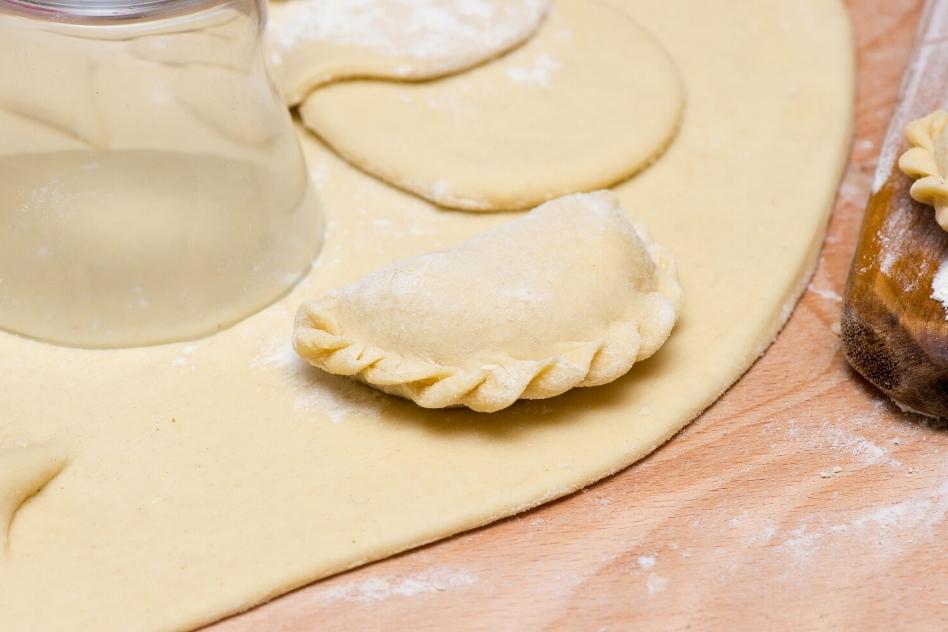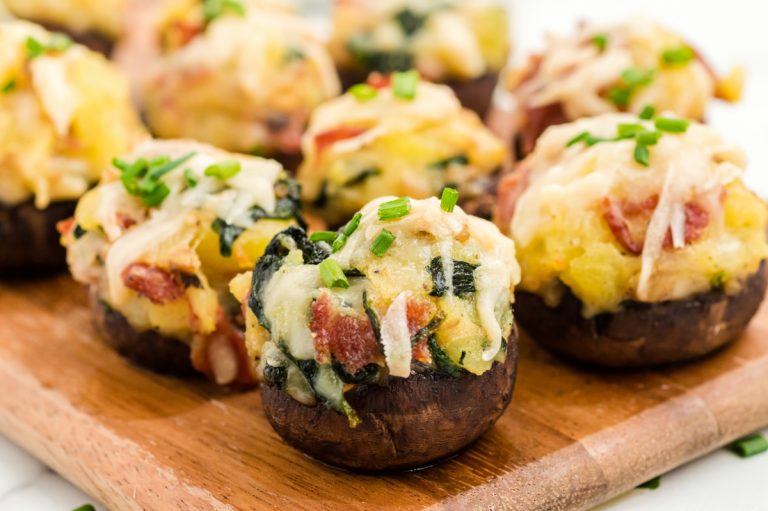Authentic Polish Pierogi Recipe
The easiest recipe to make the real Polish Pierogi! Just a few ingredients are needed for this popular Polish comfort food and your tasty pierogi will be ready in no time!
First things first – if you see a recipe for pierogis, pierogies or even worse – perogies, don’t even bother reading further as it’s not going to be an authentic Polish recipe at all.
The word pierogi is already plural, so there’s no need to add an “s” to it. A single one is called Pieróg in Polish. The word “perogies” really doesn’t exist, it’s something Americans made up.
The same goes for pierogi with cheddar cheese – if you see it somewhere, run! 😉

History of Pierogi
Any type of dumplings, including Pierogi, are originally from China, even though Eastern Europe adopted the whole idea as always theirs.
Some say Marco Polo brought these dumplings to Europe, others think it was the Tatars, and many legends have been created around it. The exact origin, however, is unknown.
In Poland, pierogi were already known in the XIIIth century, but they were more of an event dish. There were pierogi for every occasion – wedding, funeral, winter, birthday, or nameday specials.
The oldest “official” record of making dumplings, however, was found in the pages of the first Polish cookbook Compendium Ferculorum from 1682. The recipes included both savory and sweet pierogi.
Ironically, these days the boiled version is considered the traditional pierogi recipe, but they mostly showed up all over Poland during the interwar period of the XXth century, not so long ago.
In fact, less than 100 years ago when someone referred to pierogi ruskie (Ruthenian Pierogi – it’s often wrongly translated to Russian Pierogi) which these days are known as a popular filling option with potato and cheese, they meant the most traditional baked pierogi with whichever filling.
Types of Pierogi
At first, the type of pierogi depended on their shape and occasion.
Kurniki are extra-large dome-shaped pierogi filled with poultry, groats and mushrooms, made mostly for weddings and Christmas, Knysze were baked filled with buckwheat groats, while Ruskie were part of funeral rituals.
Sanież and socznie are a sweet variety prepared for Name Day parties. A miniature version filled with either mushrooms or meat – known as uszka (‘little ears’) are served in a borscht.

Different Types of Pierogi Fillings
There are many different types of Pierogi based on the filling used. Some of these fillings include:
- Meat
- Pierogi Ruskie
- Sauerkraut & Mushrooms
- Wild Mushrooms
- Fruits – blueberry, cherry, strawberry
- Cheese
- Potato and Cheese Pierogi (Russet potatoes work best!)
- Potato and herbs
- Lentils (popular in the Podlaskie region)
- Cabbage
- Spinach
- Poppyseed paste
- Quark (Farmer’s Cheese) with raisins and vanilla

Recipe Pointers For Pierogi Recipe
- You can make these pierogi in large batches and freeze them later. Simply freeze them before boiling. Pierogi are perfect for meal prep!
- If you need to, add more water while molding the dough.
- You can use salted water to boil the pierogi.
- You’ll know the pierogi are ready when they rise to the top of the boiling water.
- You can use any of the fillings mentioned above.
- After boiling them, you can fry the pierogi in melted butter, and top with diced bacon.
- Or top the pierogi with sour cream and chopped chives before serving.
- Alternatively, serve with caramelized onions!
- If you love meat, fry kielbasa sausages and serve with the Pierogi!
FAQs about Pierogi Polish Dumplings
Do I need a pierogi press to make pierogi?
No, you don’t need a pierogi press. You can seal the pierogi with your fingers. But if you want to buy a press, this one is perfect!
If you want to make a bunch of them quicker there’s also this one (my own grandma preferred it).
Can you make pierogi dough in advance?
You can make the pierogi dough up to a day ahead. Store in the refrigerator till you’re ready to shape the pierogi and cook them.
What’s the difference between pierogi and dumplings?
Pierogi are the Polish version of dumplings, but they’re made with unleavened dough.
What’s the difference between pierogi and vareniki?
Vareniki and pierogi are both Eastern European dumplings. Pierogi is what they’re called in Poland, Slovakia and Ukraine and Vareniki is what they’re called in Russia.
What is the difference between pot stickers and pierogi?
Pierogi are unleavened Polish dumplings while potstickers are Asian pan-fried dumplings.
What to serve with pierogi?
Pierogi can be served with roasted vegetables such as carrots, cauliflower, Brussels sprouts, or with salads, or dipping sauce for pierogi.
How to deal with frozen pierogi?
To freeze pierogi, prepare all the pierogi, fill them, and seal them. Then, place a sheet of plastic wrap on the bottom of your container and layer the pierogi in it.
Cover it with another layer of plastic wrap, then pierogi, and so on until the container is full. Freeze for up to 3 months. Thaw and boil or bake before serving.


Authentic Polish Pierogi Recipe

The easiest recipe to make the real Polish Pierogi! Just a few ingredients for this popular Polish comfort food and your tasty pierogi will be ready in no time!
Ingredients
- 1 lbs of flour
- 4 tablespoons of olive oil
- 1 cup of hot water
- salt
Instructions
- Mix all ingredients in a giant bowl using a wooden spoon (you can use hands, but it will be hot because of the hot water).
- Once it's all mixed, then use hands to knead the dough. The dough should be soft and elastic.
- Wrap your dough in aluminum foil and let it sit for about 30 minutes.
- Split the dough into 3 pieces to make things easier, then roll it out thinly on the board and cut out circles (either with a pierogi maker or simply a glass)
- Stuff with the desired filling and fold your pierogi in half gluing the sides together with your fingers. If it doesn't stick properly you can use some water.
- Boil your pierogi for about 3-4 minutes since they surface to the top of your water level.
Recommended Products
As an Amazon Associate and member of other affiliate programs, I earn from qualifying purchases.
Nutrition Information:
Yield:
45Serving Size:
1Amount Per Serving: Calories: 47Total Fat: 1gSaturated Fat: 0gTrans Fat: 0gUnsaturated Fat: 1gCholesterol: 0mgSodium: 13mgCarbohydrates: 8gFiber: 0gSugar: 0gProtein: 1g












Do you have someone who makes the perogies and will sell them around North
Bay?
I don’t, but there’s a Polish deli called Seakor and I know they sell pierogi.
My East European genes drove me to try to make pierogi today, a first for me. I used to make strudel so I didn’t think pierogi dough would be too hard. Wrong! While I didn’t knead it as long as for strudel I think I over-worked it. It was so elastic I struggled to roll it out; it kept creeping back! I know it needs to be stretchy enough to pull over the filling. What should I do? Longer rest? Shorter knead? When I make strudel I stretch it over a cotton sheet…use something similar to keep it from sliding back?
Where is a local babka when you need one? Any suggestions would be much appreciated! I tried to make Croatian mlinici over Christmas, after two failures I gave up. But I will not let this defeat me!
@Victoria, when the dough pulls back on you, just walk away and let it rest for 5 or 10 minutes. That will allow the gluten to relax and it should roll out easily when you return.
@Victoria,
I am thinking that maybe your dough was overworked. Once it is smooth and pliable, you are done.
How do you make uszka
How much salt?
I’m always careful when advising salt, because it’s a very preferential matter. It’s just to taste, less than 1/4 of a teaspoon.
At the beginning of the article Cheddar cheese was mentioned disparagingly. What type of ceses would be good in pierogi?
Cheddar cheese is something no Pole or Ukrainian would ever put in pierogi 🙂 Honestly, traditionally the only cheese that goes into pierogi would be twarog – type of cottage cheese (for either sweet version with raisins and sugar, or mixed with potatoes for “ruskie” savory version).
Quick question: is there a reason why you wrap the dough in aluminium foil to rest it? Rather than clingwrap, baking paper, or a dish covered with a damp cloth.
I guess personal tradition? 🙂 Others might use a clingwrap and it will work just fine, but baking paper isn’t flexible enough to cover the dough completely.